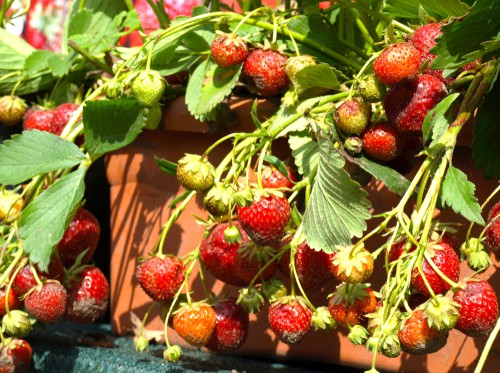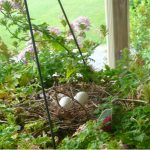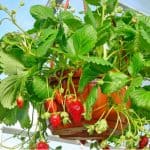Last updated on April 19th, 2022
Our site is reader supported, this means we may earn a small commission from Amazon and other affiliates when you buy through links on our site.
If you have a space for hanging baskets, you have the opportunity to grow a great many things, including trailing fruits and vegetables. Strawberry plants are one of the most popular choices for hanging baskets because their runners can trail over the edges and offer bountiful fruit. Once they are established, you can grow multiple plants in a small amount of space year after year. But how do you take care of them?
You can also grow strawberries in planters and I recently planted a strawberry planter which I documented here
Step 1: Finding the Right Location

The first step is to find the right location. Strawberries need a lot of sun, so you need to find a place to hang the basket in question where it will receive at least 8-12 hours of sun. The benefit to using hanging baskets is the compost stays warmer compared to the soil in the ground, so the plants can enjoy better growing conditions regardless. Plus, you don’t need to worry about pesky ground insects rummaging through your plants.
Step 2: Getting the Basket
You can find the perfect hanging basket at home, using supplies you already have, or in your local garden centre if you want something premade. You just need to ensure you have the right chains and hardware to hang and support the basket, and a container big enough to hold both the soil and strawberries. You can also buy custom-designed strawberry baskets where you plant the sides.
- VERSATILE: The planters are ideal for growing strawberries, herbs or flowers.
- MANY POSSIBILITIES: Each planter has 16 slits for a wide variety of planting options.
- DURABLE: These planters are made from tough polyethylene and have been UV treated to protect from sun damage.
- ANY SUNNY SPOT: Hang your planter in the garden or patio, over a door, on a balcony, in the back yard, outside the office - any sunny spot at all!
- MEASUREMENTS: Each planter is 54cm long x 23cm wide (21 inches x 9 inches). They are dark green in colour.
Inside the basket, you need soil that is light and won’t compact too easily. Mix in things like perlite to help improve drainage and air circulation, and some organic matter. Strawberries prefer acidic soil, so look for that, which means mixing in ericaceous compost.
- ERICACEOUS COMPOST - This specialist complete Ericaceous Compost has been blended to provide the right acidic soil conditions needed for optimum growth for your acid loving (lime hating) plants.
- COMPOST - Specifically designed compost for plants like Rhododendrons, Azaleas, Camellias, Heathers, Magnolias, Blueberries and similar acid loving shrubs.
- POTTING COMPOST - This amazing product is a general purpose compost, making it perfect to use for potting on or taking cuttings. Contains 20% Forest Gold wood fibre which opens the structure up.
- PLANT FERTILISER - Also includes starter fertiliser and some slow release plant feed, so no need to feed your plants for 10-12 weeks after potting.
- DETAILS - Supplied as a 60L bag with a weight of 16kg this soil will be big enough to fill a small bedding area or a large pot. Delivered direct to your door for ultimate convenience.
Step 3: Picking the Plants
Pick the right plants too. Strawberries can produce fruit in a single crop in June, or multiple crops spread out throughout summer. Pick the one you want or mix and match.
With the right plants, water the potted compost well and make sure the compost has completely absorbed the water before you put the plants in their final place. Once you put the plants in, cover them with the remaining compost until their roots are fully covered and water again thoroughly.
It’s important that you use compost and not garden topsoil because it is too heavy, may have diseases/pests, and also doesn’t drain well, and can be void of the right nutrients.
Step 4: Provide the Right Food and Water
As your strawberries are growing, you should add a slow-release fertiliser that is equal, to 10-10-10 and some compost tea. The compost tea can be mixed with water and added every few weeks during the spring when you do your regular watering. Failing that, consider using tomato feed to feed every two weeks once the strawberry plants are in flower.
- Provides a steady supply of natural nutrients
- Promotes strong, healthy growth
- Apply from Spring throughout the growing season for increased yields
- Packaging may vary
On that note, you need to be careful about watering. It can be tiring to water a hanging basket overhead regularly enough that the water doesn’t just fall right out. You might consider watering using an automatic drip system.
Trimming for winter after fruiting
When they are done fruiting, you can trim them back and keep them properly watered throughout the winter, and they will produce more crops the following spring but we recommend removing the plants in spring and replanting them into new compost.
Winter Care
If you live in an area that has particularly cold weather, you don’t have to worry so much about the ground freezing because the hanging basket isn’t in the ground. However, winter wind and strong rain or snow can be very damaging to any growth that is trailing so make sure you snip them properly in preparation for winter and if necessary take the hanging baskets down and either bury them in the ground for winter, bring them inside a greenhouse or shed, or wrap them with something like for horticultural fleece to keep the roots warm.
If you are going to store them outside make sure you store them in an area that is protected from heavy wind and check on the water level so that the soil doesn’t get waterlogged.
Replacing with new varieties
If you want to replace the varieties you have you can use the same basket but replace the compost with fresh compost, just be sure to remove the plants at the end of the year and in the spring, plant the new strawberry plant in the hanging basket with a fresh mixture of compost to add the nutrients that were depleted the previous season.
With that done on a regular basis, keep your eyes peeled for the ripened fruit and pick away. Try to prevent birds from snatching the fruit before you do though.
Related articles you may be interested in
How to grow and care for strawberry plants
How to grow tomato plants in an upside-down hanging basket
How to set up an automatic watering system
Last update on 2025-12-04 / Affiliate links / Images from Amazon Product Advertising API






